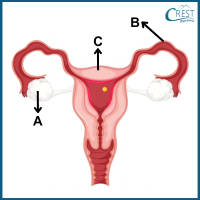1. In the following question, you will find an assertion and a reason. Select the appropriate option that applies.
Assertion: Oviparous animals produce fewer offspring compared to viviparous animals.
Reason: Oviparous animals invest more energy in the development and nourishment of their offspring before birth.
a) Both the assertion and reason are true, and the reason is the correct explanation of the assertion.
b) Both the assertion and reason are true, but the reason is not the correct explanation of the assertion.
c) The assertion is true, but the reason is false.
d) Both the assertion and reason are false.
Answer: d) The assertion is incorrect because oviparous animals actually tend to produce more offspring compared to viviparous animals. Oviparous animals lay eggs which can contain a larger number of offspring. The reason provided is also incorrect because oviparous animals invest less energy in the development and nourishment of their eggs compared to viviparous animals, where the mother provides direct nourishment to the developing embryos. Therefore, both the assertion and the reason are inaccurate in this case.
2. Why might animals living in aquatic environments often exhibit external fertilisation as a reproductive strategy?
a) Aquatic environments have a high risk of predation, so external fertilisation ensures better survival rates.
b) Aquatic environments provide a stable temperature, so internal fertilisation is not necessary.
c) Aquatic environments have abundant food sources, so energy-intensive internal fertilisation is unnecessary.
d) Aquatic environments lack proper shelter for developing embryos, favouring external fertilisation.
Answer: d) Aquatic environments often lack protective shelters for developing embryos, making internal fertilisation challenging. External fertilisation, where gametes are released into the water, increases the chances of successful fertilisation and protects embryos. Therefore, option d) is correct.
3. Researchers conducted an experiment on planaria to study the effects of fragmentation on regeneration. Which group is expected to show the highest regeneration ability?
a) Planaria divided into large fragments.
b) Planaria divided into small fragments.
c) Planaria kept intact without division.
d) Planaria exposed to high temperatures.
Answer: b) Planaria are known for their remarkable regenerative abilities. When they are divided into small fragments, each fragment contains a portion of the necessary tissues and cells for regeneration. This allows for the growth of multiple new planaria from the small fragments, making them the group expected to show the highest regeneration ability.
4. During a dissection, which female reproductive organ would you identify as the site where a developing embryo attaches and grows?

a) A: Ovary
b) C: Uterus
c) B: Fallopian tube
d) A: Oviduct
Answer: b) The uterus is the female reproductive organ where a developing embryo attaches and grows during pregnancy.
5. Consider a species of lizard that can regenerate its tail if it's lost. How might this adaptation provide a survival advantage in its natural habitat?
a) Tail regeneration helps the lizard lay more eggs.
b) Tail regeneration allows the lizard to escape predators.
c) Tail regeneration leads to asexual reproduction.
d) Tail regeneration leads to internal fertilisation.
Answer: b) The ability to regenerate a lost tail can help the lizard escape from predators. If a predator grabs onto its tail, the lizard can detach the tail and escape, leaving the predator with the tail while the lizard regrows a new one. This adaptation increases the lizard's chances of survival in its natural habitat.


